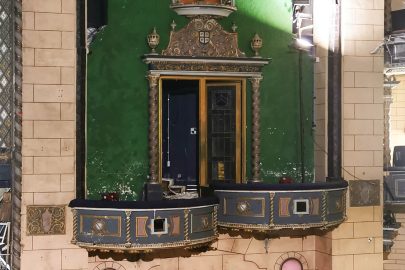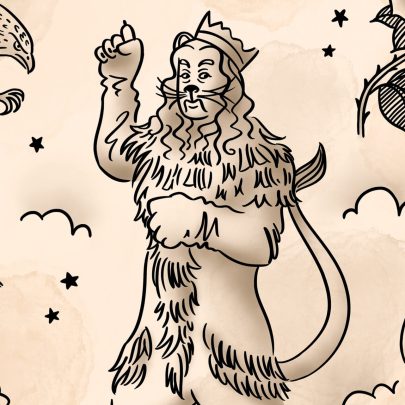Mar 2, 2016 Theatre
Observing the rehearsal room for John Psathas’ magnificent multi-media celebration of humanity in the face of war.
It’s 2.15 in the afternoon in the Michael Fowler Centre in Wellington, and seven musicians are waiting onstage, in the dark. At the back of the hall, quiet conversations. Behind the musicians are seven pod-shaped screens: they have an opaque three-dimensional depth that gives them the appearance of magic mirrors, the kind of thing from which – were this a movie – people might step, from another place, from another time.
Which is almost what happens. I’m at a rehearsal for No Man’s Land, a multi-media “love letter to peace” that combines live and filmed performance. Many of the film locations are war sites. The musicians, 160 of them in all, come from all over the world, and many of them appear in those pods. The occasion is the commemoration of the centenary of World War I; the theme of the work, as composer John Psathas puts it, is this: Humanity survives.
The musicians are lit, each in their own warm spot. Above the pods, which Psathas calls “pillars”, sits another screen, this one so big it stretches the full width of the stage. Stratis Psaradellis, an intense young man with full beard and blond hair in a braid falling to his buttocks, leans over his instrument. It’s a lira, similar in shape to a mandolin, but smaller and played vertically with a bow, and it makes a surprisingly big sound. “It’s a Constantinople lira,” he tells me later. Very small.
On the big screen, we see a forest, a grassy landscape, and it’s quickly apparent this was once a war zone: trenches all green and mossy, holes gouged from the ground where shells have exploded. The other musicians kick in, at first circling Psaradellis’ melody and then exploding into life. The show has begun.
Psathas has told me this is the first technical rehearsal, so I expect a lot of stopping and starting. But they run all the way through half the show, take a break and then run through the whole thing. Psathas tries to lower my expectations, although it’s obvious he’s pretty excited.
The musicians are really only giving half of what they’ll do on the night, he says. They’ve been together only since the weekend and this is the first time they’ve played right through. The first time they’ve had earpieces and not wedges on the floor to hear the mix through; the first time they’ve seen the film with the musicians who accompany them.
It conjures a unified stream of melodies from the disparate instruments and musical traditions of a hundred cultures, turning it all into a great flood of beauty.
It doesn’t matter, not to me. The work is intensely lyrical, tender in some parts and ecstatic in others. It conjures a unified stream of melodies from the disparate instruments and musical traditions of a hundred cultures, turning it all, despite the complications of the rehearsal, into a great flood of beauty. This is not a meditation on the horror of war. It’s a celebration of our capacity to survive it, and it’s thrilling.
A lot of the imagery is historical: soldiers at the front, on both sides, and, in some of the most affecting scenes, soldiers and nurses from both sides helping each other’s wounded. There are many other remarkable images: three percussionists from Iran, Pakistan and Senegal, playing together in the forest in Ypres; early on, Ariana Tikao singing on the cliffs above the Kapiti coastline; much later, the Armenian Serj Tankian echoing that scene, singing on the dunes above Muriwai. A Dutch brass and wind ensemble playing on a hilltop; the Syrian and Palestinian Refugees of Rap performing in underground tunnels; a recitative montage with Catholic, Orthodox and Hindu priests, a rabbi and the Grand Mufti of the Grand Mosque in Paris.
“Eighty per cent of the world was in this war,” says Psathas during the break. And that’s pretty much what he and the filmmakers, Jasmine Millet and Mathew Knight, have assembled for the show. There’s no singing in English, which means, for most of us, access to meaning bypasses the words and gets to the heart of things through the music and images. But the programme has good lists of all the who, what and where.
All too soon, it’s 5.30. Psathas stands on the stage with the musicians and some of the crew and scrolls through the long list of notes he’s made on his phone. He’s got shorter hair these days, a very cosmopolitan look. He asks the musos to free it up on stage. They’ve been looking ahead intently while they play, as if reading music. But they have no music; they’ve been watching the film on monitors. If you’re a Polish violinist and there’s another Polish woman on screen who’s all over the same melodic line as you, but with bagpipes, you want to see it.
The musicians wait. “We’ll do another run at seven,” he says, and they start to go, heading off for a quick dinner. Psathas probably won’t eat. He’s been doing really big shows for years and he knows how to stay calm, but he’s got a lot to do. The stage manager wants to know about the cueing sequences, the sound engineer has to fix the quality of the in-ear feeds, the a/v still isn’t properly sync’d, there are shadows on the big screen. Every crew member there is waiting to raise a problem.
John Psathas will be busy right up till showtime. And then it will begin. The unique, marvellous, unmissable No Man’s Land.
No Man’s Land. Wellington, March 2, festival.co.nz, Auckland March 4, aaf.co.nz.
Photo: Jack Hooker at Fort Przemysl in Poland. Photo by Jeff Avery.





